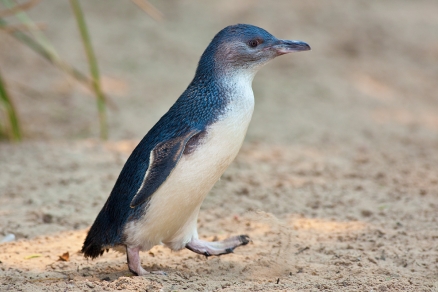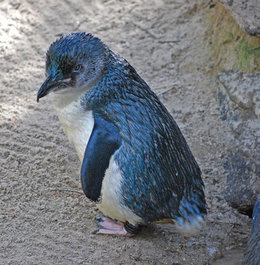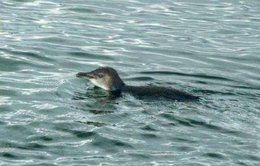Little penguin
|
Conservation Status |
|
Scientific Classification Kingdom: Animalia |
Also known as the Little blue penguin, the Blue penguin or the Fairy penguin. The Little Penguin (scientific name: Eudyptula minor) is the smallest member of seventeen species of flightless birds in the family of penguins.
Like all penguins, the Little penguin is characterized by its erect posture (although less so than other penguin species), stiff wings (flippers), excellent swimming ability, awkward movement out of water, and coloring. The dark back and white front, make penguins difficult to see when swimming, blending against the sea from above and the sky from below. The Little penguin is the only nocturnal penguin.
Six subspecies of the Little penguin have been described:
|
The White-flippered penguin (Eudyptulaminoralbosignata) is considered by some not to be a subspecies but, in fact, a separate species (or a subspecies of a separate species) under the genus Eudyptula. If this is a separate species, its conservation status is considered endangered.
Contents
Physical Description
The Little penguin is a small, flightless bird. The little penguin has a silvery bluish-black dorsum, from the top of the head to the tail. The face and neck area is a lighter gray fading into white moving down. The underparts are white, including the undersides of its flippers. The Little penguin has a dark gray bill and silvery-gray eyes. The feet are white on top, with black webs and soles. No seasonal variation has been recorded, although there are a few subspecies with slightly different coloration. One such subspecies has entirely white flippers.
Diagnostic Description: Eudyptula minor is the smallest of all penguins, with a length of 375-425 millimeters (mm), and an average flipper size of 104 mm. These animals are slightly dimorphic with the male somewhat larger than the female, with a larger, deeper bill.
Fledgelings are similar to the adults, but with a shorter, slimmer bill. The dorsal feathers are a little lighter with a more blue appearance, but fade with wear.
Reproduction
Breeding occurs mainly on off shore islands, and in some remote parts of the Southern Australian shore. The breeding season for the Little penguin is between August and December, with peak egg laying in August and November.
The Little penguin has a distinct sexual behavior. The male stands in a distinctive stance with flippers up, bill also pointed upward, accompanied by a braying call to attract a female. He will often build a nest to court her. Once male and female are mated they form a long-term monogamous pair, usually for life. Although they do not hunt for food together during the day they both come back to their shared nest at night.
The male and female copulate close to their nest, which usually is in a natural burrow or rock pile. In most cases the little penguin lays one to two white eggs, three to five days apart. Incubation begins after first egg is laid, but only partially until after the laying of the second egg, with both sexes shifting on and off every few days.
Eggs hatch within approximately 36 days, and chicks are semi-altricial, weighing about 40 grams. They are brooded for first ten days of life, and guarded continuously for the next one to three weeks, again with male and female alternating. At age three to five weeks, the chicks are guarded only at night, and then in later stages they are only visited at night by a parent for feeding.
Once a pair has bred and laid eggs both raise young together. Although eggs may sometimes be deserted there is no record of deserted young. Food is transferred directly from parent to young through regurgitation. Aggression between parents and children is rare, and only occurs when fully fledged young are driven from the nest. Adults are, however, aggressive toward young other than their own if approached for food. Fledglings usually migrate to different areas after becoming independent of their parents.
Fledgling young (90% of adult weight) leave the nest for two to three days at a time, and then finally permanently. The Little penguin reaches sexual maturity after about three years of life in both sexes.
Behavior
The Little penguin is a social bird, and is the most nocturnal of all penguin species. During the day it is either hunting at sea or in its nest sleeping. Little penguins live in loose colonies, composed of birds of all ages. They form small, very vocal groups when coming ashore at night, but then disperse to respective territories. The little penguin has a surprisingly diverse array of visual displays for many social situations. For example, fighting stances, warding off unfamiliar birds, and mating displays.
The little penguin has large range of calls, in addition to its visual displays. Sounds range from soft mewing notes, to loud screams, to growling, and even trumpeting calls.
Individuals undergo a complete body molt sometime from December to March, after the breeding season. This usually takes place at the breeding site and lasts from 10 to 18 days.
Distribution
The Little penguin is found along the shore of Southern Australia, including offshore islands, to New Zealand.
Habitat
The Little penguin prefers sandy, rocky beaches for landing at night and for nesting. The little penguin occurs in the temperate seas of Australia, feeding mainly in inshore waters around the mainland and offshore islands. Most colonies are found on sandy, rocky islands, around bases of cliffs, or near sand dunes
Food Habits
The Little penguin eats small fish (10-35 mm), some cephalopods, including arrow squids and octopi, and less often small crustaceans.
Much of the feeding of the Little penguin takes place within the top 5 m of the surface of the ocean. However, the mean dive is approximately 30 meters, with a maximum recorded dive of 69 meters. The little penguin is usually found feeding singly.
Prey is caught with a pursuit-diving technique. When Eudyptula minor sights a school of fish it will circle around the school and then dive into the middle, grabbing a fish on its way through. In some cases the penguin will seek out stragglers from the school or eat solitary fish, always swallowing underwater.
The penguin feeds daily, roughly from dawn until dusk. An irregularity in food availability may explain the bird's low metabolic rate, as compared to other species.
Conservation Status
This species is a protected native of Australia. It is common on remote islands and in a few areas of mainlanld Australia and New Zealand, where habitat is not disturbed by domestic animals and humans. Populations undergo severe crashes in some years, however, with many dead birds washing ashore. This is probably a result of food shortage or biotoxins.
This species is severely depleted where human populations have increased. They may be killed in fisherman's nets, when set too close to shore they inhabit, and also by domestic cats and dogs.
Economic Importance for Humans
Eudyptula minor is common in and around Australia and is a relatively familiar species to the people there. Tourists gather to see the nightly "penguin parade", as the penguins noisily come ashore after a day's feeding. They are relatively common in inshore waters where pleasure craft and other boats may glimpse the small bird.
References
- Eudyptula minor (J. R. Forster, 1781) Encyclopedia of Life (accessed March 25, 2009)
- Species 2000 & ITIS Catalogue of Life: 2009 Annual Checklist. Bisby FA, Roskov YR, Orrell TM, Nicolson D, Paglinawan LE, Bailly N, Kirk PM, Bourgoin T, Baillargeon G., eds (2009), Species 2000: Reading, UK.
- Eudyptula minorQuick, H. 2001. The Animal Diversity Web (online).(accessed March 25, 2009)
- International Penguin Conservation Work Group (accessed March 25, 2009)
- Blue Penguins (accessed March 25, 2009)
- Little Penguin BirdLife International (accessed March 25, 2009)
- WoRMS, World Registry of Marine Species (accessed March 25, 2009)
- IUCN Red List (accessed March 25, 2009)
- Global Register of Migratory Species (accessed March 25, 2009)
- An unexpected pattern of molecular divergence within the blue penguin (Eudyptula minor) complex Banks, Jonathan C.; Mitchell, Anthony D.; Waas, Joseph R. & Paterson, Adrian M. (2002), Notornis 49(1): 29–38.



